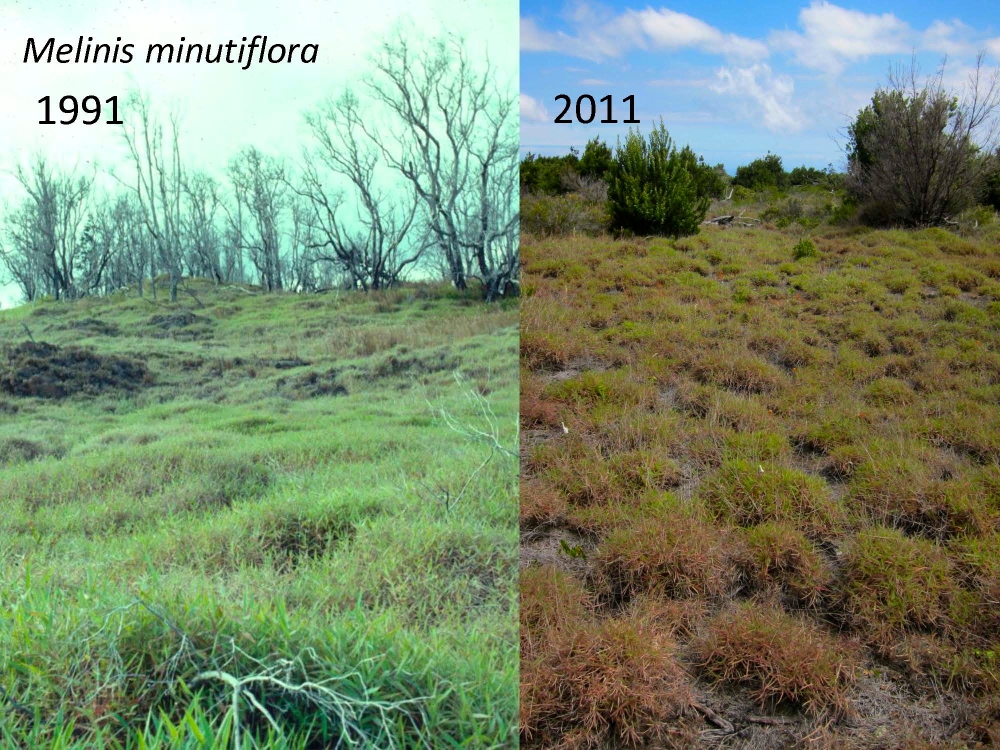
Impacts of Plant Invasions Lessen Over Time

Among the most impressive ecological findings of the past 25 years is the ability of invasive plants to radically change ecosystem function. Yet few if any studies have examined whether ecosystem impacts of invasions persist over time, and what that means for plant communities and ecosystem restoration.
UC Santa Barbara’s Carla D’Antonio, Schuyler Professor of Environmental Studies, has conducted one of the only long-term studies of plant invader impacts that spans two decades. Returning to the same grass-invaded field sites in Hawaii Volcanoes National Park that she used in her 1990-1995 studies, D’Antonio, along with postdoctoral scholar Stephanie Yelenik, gathered new data that shed light on mechanisms regulating exotic plant dominance and community change through invasion. The findings are published online today in Nature.
“We were able to take advantage of detailed studies I and others had conducted in the 1990s. We permanently marked sites we had set up and were able to go back and gain insight into how plant invasions changed over time without management,” said D’Antonio, who also is a professor in the Department of Ecology, Evolution and Marine Biology. “Such studies are important because managers have little money to control invasive species or to study how impacts might change without management.”
“Non-native plants can have very large impacts on ecosystem functioning — including altering groundwater, soil salinity or pH and pollination syndromes,” said lead author Yelenik, who earned her doctorate from UCSB’s Department of Ecology, Evolution and Marine Biology and now works for the U.S. Geological Survey’s Pacific Island Ecosystems Research Center on the island of Hawaii.
When D’Antonio and Yelenik revisited the study sites, they noticed that the invasive exotic perennial grasses (primarily an African invader called Melinis minutiflora) were dying, so they decided to repeat measures of nutrient cycling and plant community change. They found that the grasses’ self-reinforcing effects on soil nutrients had disappeared and the percentage of invader coverage had declined.
Data showed that in the past 17 years, nitrogen mineralization rates at the sites dominated by the exotic grasses declined by half, returning them to pre-invasion levels. Nitrogen mineralization is the process by which organic nitrogen is converted to plant-available inorganic forms.
“Measuring mineralization the way we do is extremely time-consuming and expensive, so we did it in snapshots of time (mid-1990s versus 2010-2012),” Yelenik explained. “This is less than ideal because differences between the two study periods could be due to differences in rainfall.”
To eliminate rainfall as a factor, the researchers examined long-term rainfall data for the region to determine if a relationship exists between nitrogen mineralization and rainfall during the study years. The data showed that rainfall during the two study periods was similar. In addition, rainfall did not correlate with differences in mineralization between time points. A mineralization assay in the lab, where moisture was kept constant, showed similar patterns to the researchers’ most recent field data, gathered in 2011 and 2012. Taken together, these results suggest that nitrogen mineralization variations between the 1990s and recent years were not due to differences in rainfall.
While the study demonstrates that ecosystem impacts and feedbacks shift over time, it also indicates that this may not necessarily help native species’ recovery. Yelenik and D’Antonio conducted a large outplanting experiment to test how a suite of native and exotic woody species responded to shifting ecosystem impacts. They added nitrogen fertilizer to mimic earlier stages of Melinis invasion and reduced Melinis competition to mimic patches during late invasion.
Similar responses occurred in five of the seven outplanted species: Growth rates and survivorship increased due to reduced competition from the exotic grasses as well as nitrogen additions. This indicates that the changing impacts of the grass over time do not alter the seedlings’ ability to grow in the ecosystem.
Two nitrogen-fixing trees were exceptions: the native Hawaiian tree Acacia koa and the exotic tree Morella faya (from the Canary Islands but invading Hawaii today). These species did much better in later Melinis invasion conditions, and Morella faya did particularly well.
“The non-native Morella faya did a lot better for various reasons, but primarily because it has a faster growth rate,” Yelenik said. “Plus in our sites it is bird-dispersed, which means it gets around and is, in fact, moving into the sites at a frightening rate. By contrast, the native Acacia did reasonably well in the experiment, but it just does not have as robust a growth rate as Morella. It is a very slow disperser and sparse in the region so we are not seeing it entering the sites on its own.”
An important lesson here is that even if plant invasions can slow down on their own given enough time, native species may need further assistance in order to make a comeback, the researchers said. Other invaders may be poised to take advantage of reduced competition from the original invader.
“Knowing the mechanisms of how and why invasions alter ecosystems is insightful for predicting what will happen, but without further management we may not get native species back,” Yelenik said. “When we see non-native species dying back and getting patchy, that may be the time to plant native species. It might turn out to be the most cost-effective way to get an ecosystem back to a more desirable state.”



